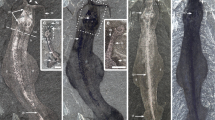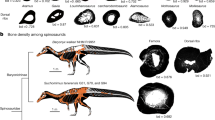Abstract
INDIRECT evidence indicates that scorpions, which first appeared in the middle Silurian, were originally aquatic organisms like their eurypterid relatives1. Living scorpions have four pairs of book-lungs, each pair situated above a sternite on the ventral surface of the mesosoma (anterior abdomen) and each book-lung opening to the outside through a stigma which perforates the sternite. By contrast, most Palaeozoic scorpions had five abdominal plates, homologues of abdominal appendages, which were apparently sutured onto the body wall only along their anterior edges. It has been suggested that there were gills above the abdominal plates2,3and that all scorpions with abdominal plates were aquatic and respired through gills2,4. The only good example, however, of a Palaeozoic scorpion with gill-like structures preserved is the Lower Devonian Waeringoscorpio5,6. Portions of book-lungs have now been discovered in two specimens of a fossil scorpion with abdominal plates from a Lower Carboniferous limestone in Scotland, providing the first direct evidence of book-lungs and also the earliest evidence of air-breathing in a Palaeozoic scorpion. Unlike Recent scorpions, the fossil lung lamellae have ribs of thicker cuticle along their posterior margins, supporting the homology of these structures with the Limulus book-gill3,7. As Silurian and Devonian scorpions were aquatic1,2 the presence of book-lungs in a Carboniferous scorpion indicates that the transition from aquatic to terrestrial environments was achieved by the direct transformation of book-gills into book-lungs.
This is a preview of subscription content, access via your institution
Access options
Subscribe to this journal
Receive 51 print issues and online access
$199.00 per year
only $3.90 per issue
Buy this article
- Purchase on Springer Link
- Instant access to full article PDF
Prices may be subject to local taxes which are calculated during checkout
Similar content being viewed by others
References
Rolfe, W. D. I. & Beckett, C. M. Spec. Pap. Palaeont. 32, 27–37 (1984).
Kjellesvig-Waering, E. N. Palaeontogr. am. 55, 1–287 (1986).
Størmer, L. Senkenbergiana lethaea 57, 87–183 (1976).
Briggs, D. E. G. Nature 326, 645–646 (1987).
Størmer, L. Sekenbergiana lethaea 51, 335–369 (1970).
Brauckmann, C. Geol. Palaeont. 21, 73–85 (1987).
Lankester, E. R. Q. J micros. Sci. 25, 339–342 (1885).
Wood, S. P., Panchen, A. L. & Smithson, T. R. Nature 314, 355–356 (1985).
Rolfe, W. D. I. Earth Sci. Conserv. 25, 22–28 (1988).
Bartram, K. M., Jeram, A. J. & Selden, P. A. J. geol. Soc. Lond. 144, 513–517 (1987).
Selden, P. A. & Jeram, A. J. Trans. R. Soc. Edinb. 80, 303–310 (1989).
Snodgrass, R. E. A Textbook of Arthropod Anatomy (Cornell University Press, New York, 1952).
Shear, W. A. et al. Am. Mus. Novit. 2901, 1–74 (1987).
Claridge, F. M. & Lyon, A. G. Nature 191, 1190–1191 (1961).
Vogel, B. R. & Durden, C. J. J. Palaeont. 40, 655–658 (1966).
Author information
Authors and Affiliations
Rights and permissions
About this article
Cite this article
Jeram, A. Book-lungs in a Lower Carboniferous scorpion. Nature 343, 360–361 (1990). https://doi.org/10.1038/343360a0
Received:
Accepted:
Issue Date:
DOI: https://doi.org/10.1038/343360a0
This article is cited by
-
Exploring the evolution and terrestrialization of scorpions (Arachnida: Scorpiones) with rocks and clocks
Organisms Diversity & Evolution (2019)
-
Homeosis in a scorpion supports a telopodal origin of pectines and components of the book lungs
BMC Evolutionary Biology (2018)
-
Carboniferous arachnids from the Graissessac Basin, Central Massif, France
Paläontologische Zeitschrift (2016)
-
Sperm carriers in Silurian sea scorpions
Naturwissenschaften (2011)
-
Fossils of large terrestrial arthropods from the Lower Devonian of Canada
Nature (1996)
Comments
By submitting a comment you agree to abide by our Terms and Community Guidelines. If you find something abusive or that does not comply with our terms or guidelines please flag it as inappropriate.



